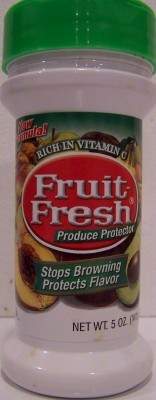
Looking for How to Freeze Peaches, Plums, Figs, Nectarines and Cherries, Easily! With Step-by-step Directions, Photos and Recipes in 2024? Scroll down this page and follow the links. And if you bring home some fruit or vegetables and want to can, freeze, make jam, salsa or pickles, see this page for simple, reliable, illustrated canning, freezing or preserving directions. There are plenty of other related resources, click on the resources dropdown above. If you are having a hard time finding canning lids, I've used these, and they're a great price & ship in 2 days.
If you have questions or feedback, please let me know! There are affiliate links on this page. Read our disclosure policy to learn more.
How to Freeze Peaches, Plums, Figs, Nectarines and Cherries, Easily! With Step-by-step Directions, Photos and Recipes
How to Freeze Peaches, Plums, Figs, Nectarines and Cherries, Easily!
Yield: as much as you like
Click here for a PDF print version
If you like peaches, nectarines or plums in the winter for cobblers, pies or just in a bowl; just imagine how good it would taste if you had picked a couple of quarts fresh or bought a them from a farm stand and then quickly froze them at home! It is also one of the simplest ways to put up a fruit for the winter. Here's how to do it, complete instructions in easy steps and completely illustrated.
In the winter when you pull them from the freezer, the fruit will taste MUCH better than anything you've ever had from a store. You can also use little or no sugar at all. Peaches, plums, cherries or nectarines can be packed in very light, light or medium sugar syrup. They can also be packed in water, apple juice or white grape juice.
Prepared this way, the frozen fruit will have a freezer life of about 12 months.
If you would rather can your fruit, see my page on how to make home canned peaches from fresh! It is really SO easy! And here are some great and easy peach desert recipes!
Directions for Making Frozen Peaches, Plums, Cherries, Nectarines, Figs and Other Similar Soft Fruit
Ingredients and Equipment
- Fruit (see step 1)
- Jar funnel ($4 at mall kitchen stores and local "big box" stores, but it's usually cheaper online from our affiliates)
- At least 1 large pot
- Large spoons and ladles,
- Ziploc freezer bags, quart size or a vacuum food sealer and bags for it.
- Sugar (or other sweetener: Stevia (in a prepared form like Truvia, it measures same as sugar; if you use another form, you will need do your own conversion) - or Splenda, if you prefer, , Nutrasweet, or fruit juice)
Recipe and Directions
Step 1 - Selecting the peaches, plums, cherries or nectarines
 The most important step! You need peaches that are sweet, and to
make the work easier, cling-free (also called freestone). This means
that the peach separates easily from the pit!
Same with nectarines, and this doesn't apply to cherries or plums.
The most important step! You need peaches that are sweet, and to
make the work easier, cling-free (also called freestone). This means
that the peach separates easily from the pit!
Same with nectarines, and this doesn't apply to cherries or plums.
Choose ripe, mature fruit. They should not be mushy, but they also should not be rock hard: just as ripe as you would eat them fresh. Green, unripe peaches will soften but will not ripen, nor have the flavor of tree-ripe peaches.
After this step, I'll just refer to "peaches" but it applies to plums, cherries and nectarines.
Step 2 - How many peaches and where to get them
You can pick your own, or buy them at the grocery store. For very large quantities (more than a few bushels), you will find that real* farmer's markets, like the Farmer's Market in Forest Park, Georgia have them at the best prices.
It takes about 5 good sizes peaches or nectarines (or about 10 plums) to make one quart or frozen peaches.
* - not the cutesy, fake farmer's markets that are just warehouse grocery stores that call themselves farmer's markets.
Step 3 - Prepare the sugar (or other sweetener) solution
Peaches must be packed in a solution of water and sugar or fruit juice. It's up to you which to use. Sugar is added to improve flavor, help stabilize color, and retain the shape of the fruit. You only need enough solution to cover the peaches; about 1 cup per quart. It is not added as a preservative; but the solution does prevent drying, freezer burn and oxidation (browning). Peach, white grape or apple juice works great and is a natural alternative to using processed sugar!
| Type of Syrup | Sugar | Water | Yield |
| Fruit juice (peach, apple or white grape) | 0 | 0 | 4 cups |
|---|---|---|---|
| Stevia (in a prepared form like Truvia, it measures same as sugar; if you use another form, you will need do your own conversion) - or Splenda, if you prefer, (2 cups) | 0 | 6 cups | 6 cups |
| Light sugar | 2 cups | 6 cups | 7 cups |
| Medium sugar | 3 cups | 6 cups | 7.2 cups |
| Heavy sugar | 4 cups | 6 cups | 7.4 cups |
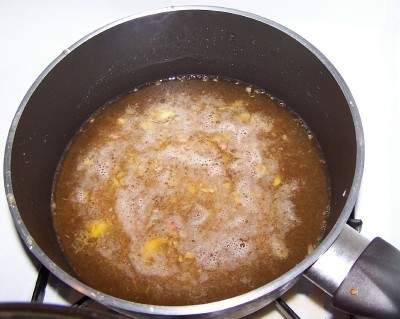
Fruit juice syrup requires no preparation. To prepare sugar and Stevia (in a prepared form like Truvia, it measures same as sugar; if you use another form, you will need do your own conversion) - or Splenda, if you prefer, syrups, while heating the water in a pot on the stove (or microwave), add sugar slowly, stirring constantly to dissolve. Once it is dissolved remove it from the heat. After preparing the liquid syrup, let it cool before mixing it with the peaches!
Note: You can "dry pack" peaches and other stone fruits, and use not liquids or sugar. The results aren't as good, though, as they are more subject to freezer burn and oxidation.
Step 4 -Wash the peaches!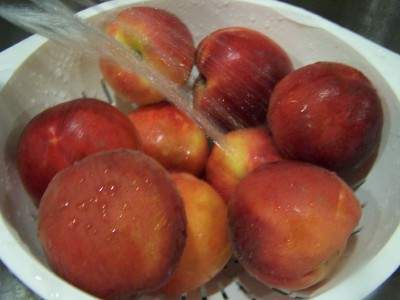
I'm sure you can figure out how to wash the peaches in plain cold or lukewarm water.
Step 5 - Peeling the Peaches
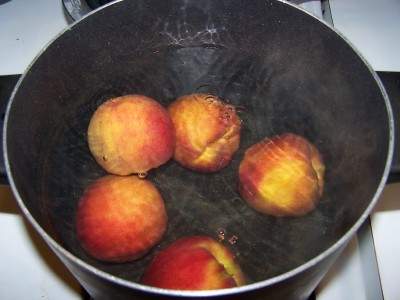
Nope, we're not going to peel them by hand; that's way too much work. Instead, here's a great trick that works with many fruits and vegetables with skins (like tomatoes): just dip the fruit in boiling water for 20 to 45 seconds.
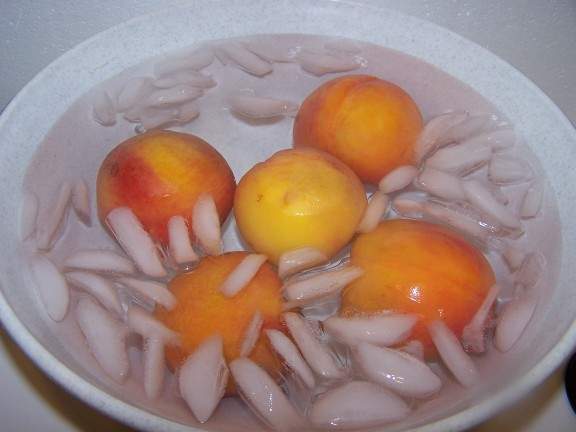 Remove from the
boiling water using a slotted spoon and put into
a large bowl or pot of cold water and ice for several minutes
Remove from the
boiling water using a slotted spoon and put into
a large bowl or pot of cold water and ice for several minutes
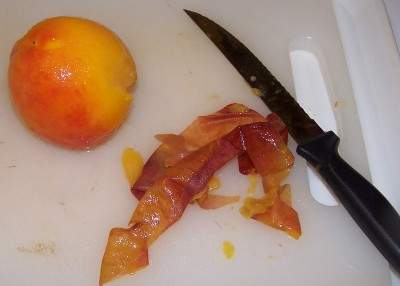 The skins will easily slide off
now!
The skins will easily slide off
now!
Nectarines do not need to be peeled, if you don't mind the skins. Neither do peaches, but most people prefer them with skins off - they tend to be slimy after all this.
Step 6 - Cut up the peaches
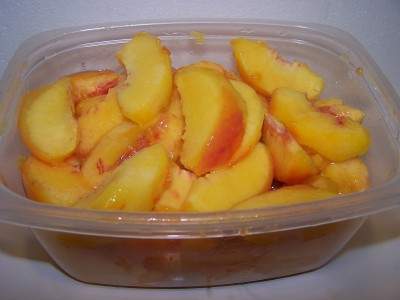 Cut out any brown spots and mushy areas. Cut the peaches in half, or
quarters or slices, as you prefer! Remove pits!
Cut out any brown spots and mushy areas. Cut the peaches in half, or
quarters or slices, as you prefer! Remove pits!
Step 7 - Prevent the fruit from darkening!
Peaches will turn brown when exposed to air, even air in a sealed,
sterile jar. To keep the fruit from turning brown, when you get a bowlful,
sprinkle 1/4 cup lemon juice or Fruit-Fresh (which is just a mix of citric acid and vitamin C, perfectly natural). Then stir the peaches to make sure
all the surfaces have been coated.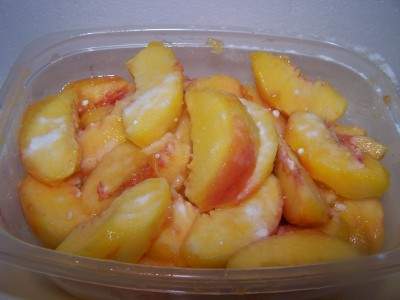
Step 8 - Mix the peaches with the sweetener solution
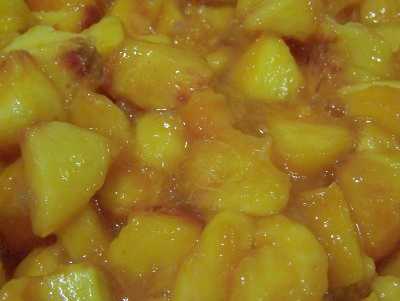 In a large bowl, combine the peaches and sweetener solution. Mix
completely.
In a large bowl, combine the peaches and sweetener solution. Mix
completely.
Step 9 - Fill the bags and exclude air pockets
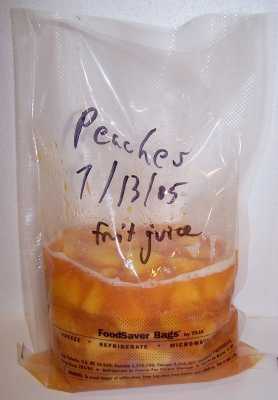
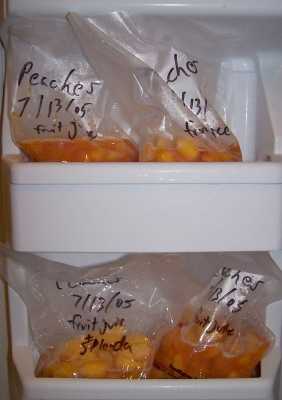
Ladle the peaches and solution into the freezer bags.
A. Ziploc Bags
If you are using ziploc bags, squeeze out any air bubbles and seal them. put them in the freezer on the coldest shelf. Since peaches, nectarines, plums, figs, and other soft fruit will be covered in a liquid, it is quite easy to remove all the air with a ziploc bag! Be sure to use the "freezer ziplocs", not the regular ones. The freezer ones are thicker and will be much less like to break, split or allow freezer burn. TIP: If you don't own a vacuum food sealer to freeze foods, place food in a Ziploc bags, zip the top shut but leave enough space to insert the tip of a soda straw. When straw is in place, remove air by sucking the air out. To remove straw, press straw closed where inserted and finish pressing the bag closed as you remove straw.
B. Vacuum Food Sealer
If you are using a vacuum food sealer, stand the bags
upright on the shelves on the door of your freezer (so they don't spill)
and allow them to freeze overnight (vacuum food sealers require liquids
to be frozen first, or they would be sucked into the pump!)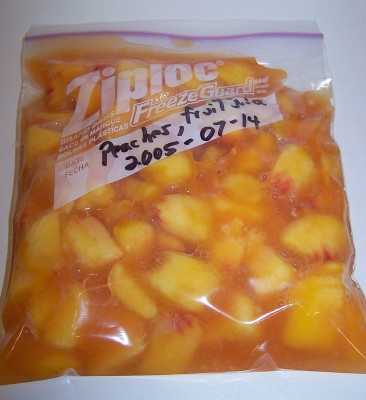
The next day, take the bags out of the freezer, seal them and pop them back in the freezer!
If any of the frozen peaches are exposed on the surface, just pour a little more sugar syrup (or fruit juice, etc.) to cover them and put it back in the freezer. When that freezes, you can seal them.
Photos above at right, from top to bottom:
- Peaches in foodsaver bags standing upright, unsealed, in the freezer; to be frozen.
- Peaches in a foodsaver bag waiting to be frozen then sealed
- Peaches in a ziploc bag with the air excluded, ready for the freezer.
Freezing keeps peaches safe to eat almost indefinitely, but the recommended maximum storage time of 12 months is best for taste and quality. The quality of the frozen peaches is maintained best in a very cold freezer (deep freezer), and one that keeps them frozen completely with no thaw cycles. Excluding any air from inside the bags which leads to freezer burn, by using vacuum-sealed bags, is also important to maintaining quality
Tips!
- To use them, just set them in the fridge overnight, or on the counter for a couple of hours. I wouldn't recommend the microwave unless you are planning to cook with them!
- Allow about 1/2 inch of head space. Do not use glass because the expansion in the freezer will break the glass. (yes, if you leave enough headspace, it may work some of the time...)
- If fruit is not covered by liquid it may darken or get freezer burn during storage (but does not necessarily mean it is spoiled, as all fruits will darken somewhat). To avoid this, remove all air bubbles and while the bags are freezing, stand them so that the fruit is entirely covered by liquid.
Frequently Asked Questions
Q. Can I freeze peaches dry without any sweetener?
A. Yes. You might get some freezer burn, so you might want to add a little juice (peach or white grape) to fill the air spaces. Or pack them dry using a vacuum food sealer which would eliminate the need to add juice and still avoid most freezer burn.
Looking for canning equipment and supplies?
Water bath canner with a jar rack
Pressure canners for gas, electric and induction stoves: Presto 23Qt or T-fal 22Qt
Canning scoop (this one is PERFECT)
Ball Blue book (most recent version)
Find Other types of farms:
- Easter egg hunts
- Children's consignment sales
- Farm markets and roadside stands
- Road trips and camping resources
- Local Honey, apiaries, beekeepers
- Local Meat, Milk and Eggs
- Consumer fraud and scams information
- Home canning supplies at the best prices on the internet!
- Maple Syrup Farms, sugarworks, maple syrup festivals
- Environmental information and resources
- Farms For Your Event for birthday parties, weddings, receptions, business meetings, retreats, etc.
- Festivals - local fruit and vegetable festivals
- Pumpkin patches and corn mazes
- Christmas Tree Farms and lots
Get the
most recent version of
the Ball Blue Book
Get the
most recent version of
the Ball Blue Book of Home Canning
Find other types of farms:
- Easter egg hunts
- Children's consignment sales
- Farm markets and roadside stands
- Local Honey
- Local Meat, Milk and Eggs
- Road trip and camping
- Pumpkin patches and corn mazes
- Christmas Tree Farms and lots
- Maple Syrup farms and sugarworks
Highly rated canning supplies:
- Regular Mouth Canning Lids with food-grade with BPA Free Silicone seals for Ball, Kerr Jars for Canning
- Canning accessories kit: funnel, jar tongs, lid lifter, etc
- Food Dehydrator, 400W Electric with 8 Trays, 48 hour Timer and Temperature Control 95-176℉, BPA-Free
- Water Bath Canner, 21 Qts with lid, Jar Rack, Speckled Black, cans 7 quart jars, 9 pint jars or 13 half-pint jars
- Air Fryer: Instant Pot Instant Vortex Plus XL 8QT Clear Windows, Custom Programming, 8-in-1 Functions that Crisps, Broils, Roasts, Dehydrates, Bakes, Reheats
- Pressure canner: All American 921, 21.5qt Pressure Cooker/Canner, never needs gaskets, Great for Gas, Electric or Flat Top Stoves - Made in the USA
- The Backyard Homestead:a guide to homesteading , on 1/4 acre, how to raise grains and vegetables; raise animals for meat, eggs, and dairy; and keep honey bees
- Smart silent HEPA Air Purifiers for Home, Large Rooms for Allergies, Smoke, Pets. Eliminates 99.97% of Dust, Pet Hair, Odors
